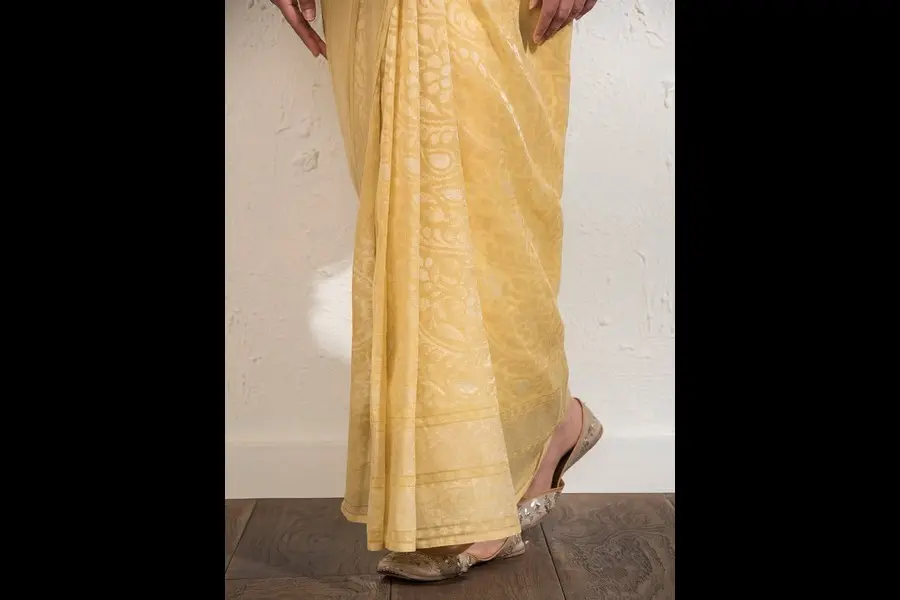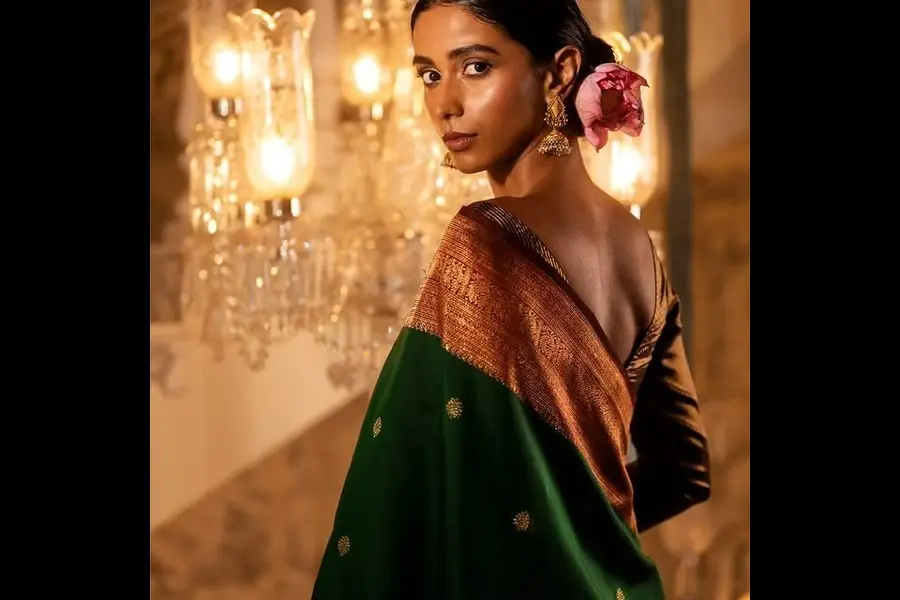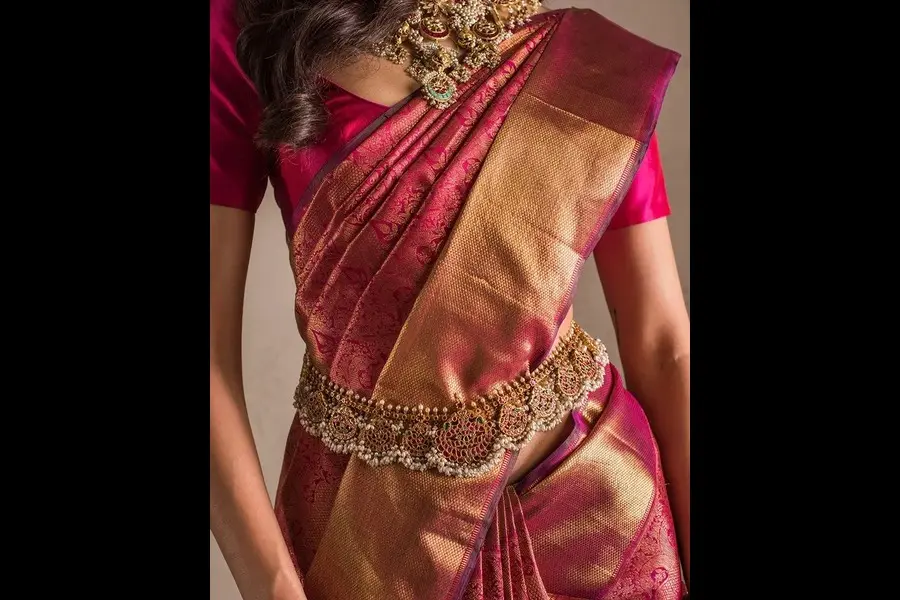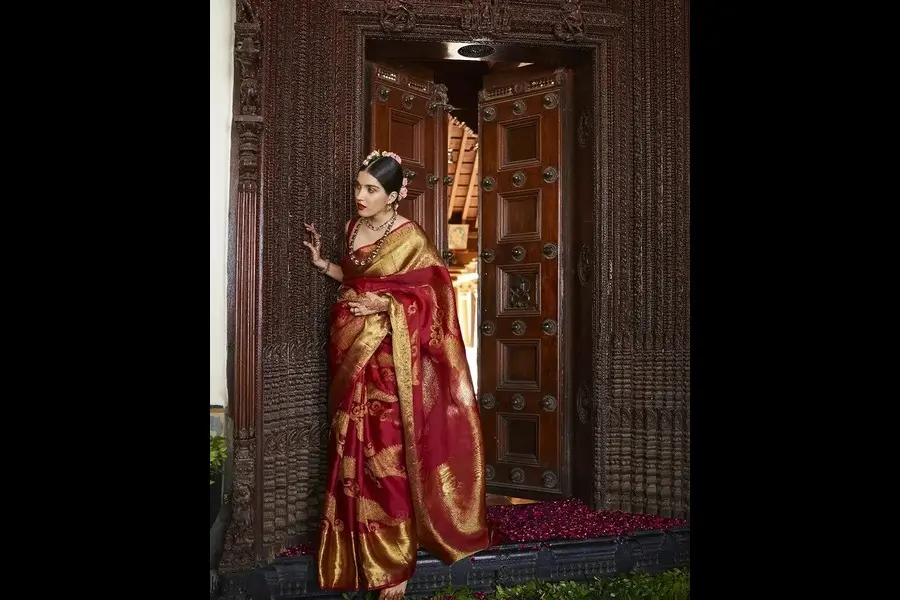Navratri is a festival that transcends celebration; it is a dialogue between tradition, devotion, and personal expression. Each of the nine days honours a distinct form of Goddess Durga, and the colours associated with these days are far more than aesthetic choices; they are reflections of the goddess’s attributes—red for courage, blue for serenity, yellow for optimism, and so forth. Dressing in these colours is a symbolic gesture, yet it offers a modern woman a unique opportunity to align her personal style with intention. Choosing the right fabric, drape, and silhouette can transform a traditional outfit into a statement of elegance and practicality.
Here is a guide to navigating the festival through colour and style, blending heritage with contemporary sensibilities while staying true to the festival’s spirit.
Day 1: Red – Vitality and Assurance
Red, representing Goddess Shailaputri, embodies energy and courage. A classic silk saree, Kanjeevaram or Banarasi, anchors the day’s ritual attire, but modern adaptations like corset-style blouses or structured tops allow ease of movement without compromising the saree’s inherent grace. Drapes such as mermaid-style pleats or open pallu variations introduce fluidity and presence. Minimal gold or kundan jewellery can enhance the look subtly, keeping the focus on the intensity of red. One such piece that captures this balance exquisitely is the Advaya Organza Kanjivaram from Angadi Heritage, one of the best saree stores in Bangalore. It’s never-seen-before dramatic, floating jaal flows effortlessly, each motif placed like brushstrokes, flowing with every pleat.
Day 2: Blue – Composure and Reflection
Blue, the colour of Goddess Brahmacharini, signifies tranquillity and introspection. Cotton-silk blends or handwoven Chanderi fabrics provide comfort while maintaining elegance. Traditional drapes, such as the Gujarati seedha pallu, can be paired with a belt or a structured blouse for a refined modern interpretation. Lightweight blue sarees from thoughtfully curated stores cater to a lifestyle where ceremonial devotion coexists with practicality, ensuring long hours of wear remain effortless.
Day 3: Yellow – Optimism and Renewal
Yellow, associated with Goddess Chandraghanta, reflects optimism and prosperity. Linen or muslin jamdani sarees in soft, muted shades offer freshness and lightness. Drapes like Bengali-style pleats or pre-stitched options bring ease to day-long ceremonies and dances. Jewellery in gold or pearls provides understated sophistication. Among these, the Banarasi Muslin Jamdani from The House of Angadi stands out, glimmering with zari yet breathing like cotton. It combines heritage and lightness, making it ideal for days when the air feels still but one still wishes to feel moved.

Day 4: Green – Growth and Balance
Green, representing Goddess Kushmanda, embodies harmony and renewal. Fabrics such as Chanderi or cotton-silk contemporary blends provide versatility from morning rituals to evening gatherings. Layered pleats or half-and-half drapes infuse movement without compromising structure, while statement or embroidered blouses elevate the overall aesthetic. Greens reflect a sensitivity to texture and weave, offering modern women options that honour both form and function. This green Kanjeevaram with gold zari, available at The House of Angadi, plays with texture and form, using fine gathers to give the fabric a gentle, architectural movement.

Day 5: Grey – Poise and Composure
Grey symbolises patience and calm, attributed to Goddess Skandamata. Lightweight crepe or georgette fabrics provide a minimalist yet sophisticated canvas for the day. Draping techniques like half-and-half or layered pleats offer contemporary subtlety, while silver or oxidised jewellery complements without distraction. Refined grey options provide understated elegance suited to a modern ceremonial lifestyle.
Day 6: Orange – Confidence and Presence
Orange, the colour of Goddess Katyayani, exudes confidence. Silk-cotton blends in muted or bright shades are practical for evening garba as well as morning rituals. Drapes like butterfly pallu or mermaid-style pleats add movement, while lightly embroidered blouses provide a contemporary balance to traditional fabric. The interplay of colour, texture, and form celebrates both festive exuberance and everyday wearability, giving modern women garments that are as functional as they are expressive.
Day 7: White – Simplicity and Clarity
White marks Goddess Kaalratri’s day, reflecting purity and composure. Fabrics such as cotton, silk, or organza provide comfort while radiating subtle elegance, perfect for both morning rituals and evening gatherings. Drapes like layered pleats or a double pallu introduce gentle dimension and fluidity without adding complexity, allowing the wearer to move gracefully. Light embroidery, delicate motifs, or pastel-hued blouses can add refinement, elevating the overall look without overpowering the calm simplicity of white.
Day 8: Pink – Grace and Subtlety
Pink, associated with Goddess Mahagauri, conveys compassion and gentleness. Soft silk or chiffon sarees in magenta or rose tones can be styled traditionally or in pre-pleated formats for ease. Minimalist belts or contemporary blouses offer functional elegance. Carefully curated pink pieces in Bangalore blend artisanal craftsmanship with muted modernity, allowing wearers to embrace feminine grace without ostentation. Among these, the Eternal Series saree fromAdvaya, showcased at Angadi Galleria in magenta and gold, stands out, not merely as an outfit, but as a celebration of timeless elegance and thoughtful artistry.

Day 9: Purple – Depth and Transformation
Purple, representing Goddess Siddhidatri, speaks of spirituality and refinement. Fabrics such as velvet, brocade, or silk evoke depth, while modern drapes, cape-style blouses or structured overlays introduce sophistication. Accessories in muted gold or silver provide just the right accent, maintaining harmony and allowing the saree’s richness to remain the focal point. Purple showcases the elegance of timeless craftsmanship, where intricate weaves and thoughtful details come alive in designs that resonate with contemporary sensibilities, making the wearer feel poised, graceful, and deeply connected to tradition.
Navratri is an opportunity to navigate the intersection of devotion, heritage, and modern lifestyle. By choosing colours and fabrics that resonate with each goddess, experimenting with drapes, and integrating contemporary touches, women can honour tradition without compromising practicality or individuality. From silk weaves to versatile modern drapes, the nine days of Navratri go beyond being just a festival of colour but a celebration of intention, style, and subtle sophistication.
Also Read-
- Reimagining Your Closet: Fashion Tricks You Haven’t Tried Yet
- Significance to Style: Saree Ideas for the Nine Days of Navratri
- Top Content Marketing Platforms Incorporated By Content Marketing Agencies In Australia and the UK
